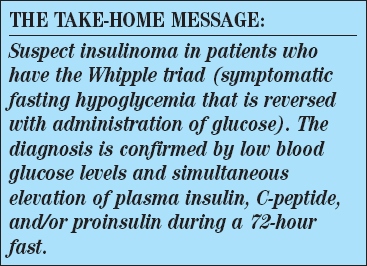Insulinoma in Elderly Man
A 75-year-old man is brought to the emergency department (ED) after awakening in the night very confused and disoriented. His wife had called 911; when the paramedics arrived, they found his blood glucose level to be 36 mg/dL.
A 75-year-old man is brought to the emergency department (ED) after awakening in the night very confused and disoriented. His wife had called 911; when the paramedics arrived, they found his blood glucose level to be 36 mg/dL. Intravenous dextrose was administered on the way to the hospital. In the ED, he is fully awake, lucid, and oriented. A second blood glucose level is 90 mg/dL.
HISTORY
The patient has had several similar episodes over the past year; all of these occurred within 2 to 3 hours of a large meal. He denies any change in weight, bowel habits, or appetite. He has a history of bilateral knee replacement and hernia but no diabetes, coronary artery disease, hypertension, or other major medical diagnosis. His only medications are a multivitamin supplement and occasionally acetaminophen. His grandfather had type 2 diabetes mellitus.
PHYSICAL EXAMINATION
Temperature is 37°C (98.6°F); heart rate, 68 beats per minute; and blood pressure, 138/84 mm Hg. Head, ears, eyes, nose, and throat are normal. No carotid bruits or enlarged lymph nodes are detected. Chest is clear and heart rhythm is regular, without murmurs or gallops. Abdomen is nontender, with no masses or organomegaly. Results of a detailed neurological examination are normal.
LABORATORY RESULTS
Results of a chemistry panel are normal (including a creatinine level of 0.9 mg/dL and a blood glucose level of 114 mg/dL). A hemogram is also normal.
Which of the following studies would be most likely to yield a definitive diagnosis?A. Measurement of a fasting cortisol level followed by an adrenocorticotropic
hormone (ACTH) stimulation test.
B. Abdominal CT.
C. Measurement of plasma catecholamine and calcitonin levels.
D. A 72-hour fast with simultaneous measurements of blood glucose, plasma insulin, C-peptide, and proinsulin levels.
(answer on next page)
CORRECT ANSWER: D
This patient presented with fasting hypoglycemia that was symptomatic and that was reversed with administration of glucose-a constellation of findings known as the Whipple triad. The most likely diagnosis is insulinoma.
Insulinoma: an overview. Insulinoma affects 1 to 2 persons per million annually. Epidemiologically, this man is a somewhat atypical patient: the disease is more common in women, and the median age at onset is 45 years. However, his symptoms are quite typical.1
Insulinomas are most often benign adenomas (80% of cases) that are nearly always found in the pancreas. About 10% of patients have multiple adenomas; 5% have carcinomas; and in another 5%, insulinomas are part of a multiple endocrine neoplasia syndrome.2

When insulinoma is suspected, the diagnosis is established by demonstrating inappropriately elevated levels of plasma insulin, C-peptide, and/or proinsulin in the setting of abnormally low blood glucose levels. This can be done by performing the appropriate studies during an episode of fasting hypoglycemia recognized because of symptoms- or more commonly, by having the patient fast for 72 hours under controlled conditions while simultaneously and serially measuring blood glucose levels along with the insulin moieties mentioned in choice D. Any of the following abnormal findings are considered diagnostic when they occur during a state of fasting hypoglycemia:
•Plasma insulin level greater than 5 μIU/mL.
•C-peptide level greater than 0.75 ng/mL.
•Plasma proinsulin level greater than 5 pmol/L.3
Insulinomas tend to be small (average size, about 2 cm) and thus are not always evident on routine CT scanning (choice B). More refined techniques, such as endoscopic ultrasonography or dual-phase spiral CT scanning, are frequently required to localize these tumors. Even today, a significant majority of insulinomas are identified by palpation at surgery.4 Thus, CT scanning (choice B) would not be the best diagnostic test for this patient.
Other causes of fasting hypoglycemia. Hypoglycemia is certainly a feature of hypoadrenalism, or Addison disease. However, other findings associated with the hypocortisol state, such as hypotension and electrolyte abnormalities (hyponatremia and hyperkalemia), would be expected. This patient never exhibited any of these findings during extensive serum measurements and clinical monitoring. Thus, Addison disease is unlikely here, and measurement of a fasting cortisol level followed by an ACTH stimulation test (choice A) is not recommended.
A multiple endocrine neoplasia syndrome is often identified by measuring catecholamines (choice C) secreted by a coexistent pheochromocytoma. However, this man had neither documented steady-state hypertension nor paroxysms of hypertension. Thus, multiple endocrine neoplasia is unlikely here, and early measurements of catecholamines are not the optimal initial diagnostic study.
Outcome of this case. A 72- hour fasting study was performed. At hour 28, blood glucose levels started to decline; they reached levels of 39 to 50 mg/dL between hours 32 and 36. At hour 32, the insulin level was 9 μIU/mL, the C-peptide level was 2.2 ng/mL, and the proinsulin level was 75 pmol/L.
An abdominal CT scan showed a "normal pancreas," but endoscopic ultrasonography revealed a 9 x 10-mm hyperechoic mass in the body of the pancreas consistent with an insulinoma. The tumor was removed by laparoscopic enucleation and was shown to be benign. One year after the procedure, the patient is doing well and has had no recurrent symptoms.
References:
REFERENCES:
1
. Brugge WR, Van Dam J. Pancreatic and biliary endoscopy.
N Engl J Med.
1999;341:1808-1816.
2
. Hart SP, Frier BM. Causes, management and morbidity of acute hypoglycaemia in adults requiring hospital admission.
QJM
. 1998;91:505-510.
3
. Le Roith D. Tumor-induced hypoglycemia.
N Engl J Med.
1999;341:757-758.
4
. McDermott JH, Kent PD, Service FJ. 67-Year-old woman with recurrent hypoglycemia.
Mayo Clin Proc.
2001;76:939-942.
FOR MORE INFORMATION:
•Grant CS. Insulinoma. Best Pract Res Clin Gastroenterol. 2005;19:783-798.
•Sharma T, Katz CM, Rutecki GW. Unexplained hypoglycemia: a focused approach to finding the cause. Consultant. 2008;48:665-671.